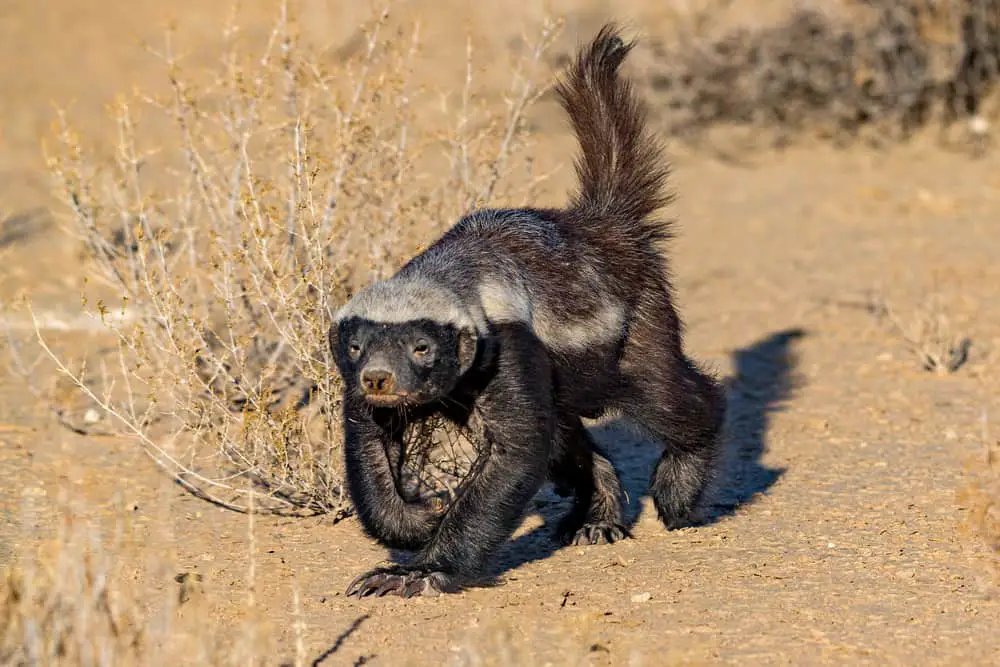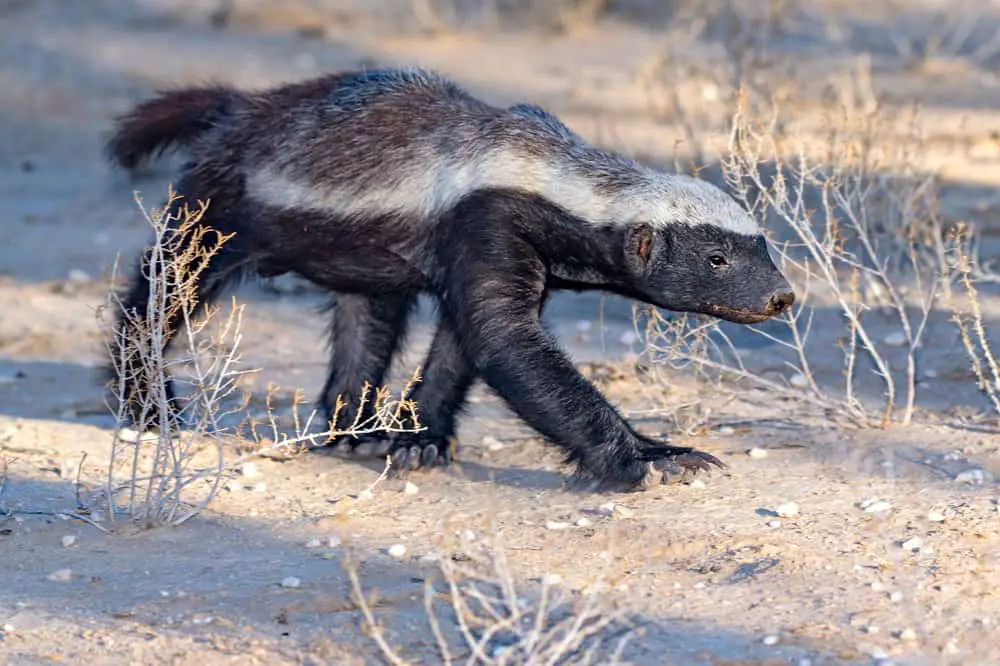The honey badger (Mellivora capensis) is a species of mustelid native to Africa and Southwest Asia. It is the only member of its genus and has become widely known for its extraordinary strength, determination, and courageousness in the face of danger.
The purpose of this article is to provide an overview of the physical characteristics, behavior patterns, diet preferences, habitat requirements, and conservation status of honey badgers.
Physical Characteristics: Honey Badgers are relatively small mammals with long bodies and short legs. They have distinctive black-and-white stripes on their backs that extend from head to tail and thick skin covered with coarse fur. Their heads are large in proportion to their body size with broad muzzles full of sharp teeth adapted for consuming prey such as rodents, reptiles, amphibians and birds.
Behavior Patterns: Honey badgers exhibit highly adaptable behavior which enable them to thrive in diverse habitats throughout Sub-Saharan Africa including savannahs, forests, scrublands and even deserts.
They are mainly nocturnal animals but may also be active during daylight hours when there is little human activity around. Wild honey badgers typically live solitary lives except during mating season or when raising young cubs together in dens located underground or within hollowed out trees or logs.

Characteristics
The honey badger, also known as the ratel, is a species of mustelid native to Africa, Southwest and Central Asia, India and western parts of China. It has distinctive coloration with short black fur on its back and upper sides that blends into white or yellowish-gray underneath.
The fur type is coarse and bristly where it covers the head and neck. These animals have an elongated body shape measuring up to 28 inches long with a tail length ranging from 2.4 – 4 inches in size. Their weight can range anywhere from 6 – 16 pounds depending on their age and region they are found in.
Honey badgers have powerful musculature which gives them great strength for their size. This allows them to take on prey much bigger than themselves such as snakes, porcupines, lizards and birds.
They are able to stand upright when necessary while digging or attacking predators like lions or wild dogs although this posture is rare among mammals other than primates. A honey badger’s life span in the wild can range up to 25 years but may be shorter due to predation by larger carnivores or humans hunting them for their skin and meat.
Habitat
The habitat of the honey badger is quite wide-ranging and can span across several different biomes. They are distributed throughout Africa, Southwest Asia, and India in deserts, grasslands, woodlands, wetlands, and subtropical regions.
One reason for their versatility as a species is that they have adapted to hunt many types of prey found in these habitats. This includes snakes but also small mammals such as hares or rodents. They may even eat insects or fruits when available.
Honey badgers prefer areas with thick vegetation, which provides them shelter from predators like hyena’s and leopards, who often try to steal honey badger kills.
Due to this need for cover from predators and the ability to search for food sources efficiently, honey badgers are most commonly found in savannas where there is open land but spots of trees or shrubs providing effective hiding places. Honey badgers will also establish dens near waterholes if possible so they can stay hydrated while hunting during hot days.
These den sites must be well hidden due to the risk of being attacked by larger predators searching for an easy meal.
On occasion some honey badgers travel long distances between suitable habitats looking for more favorable conditions; however this behavior does not seem very common among established populations living in one region over extended periods of time.
Ultimately the flexibility of the honey badger allows it to survive in harsh environments around the world despite formidable competition from other animals occupying similar niches within its range of distribution.
Diet
The diet of the honey badger is widely varied and opportunistic. They are known to feed on insects, termites, rodents, lizards and even fruits. In addition they have been known to eat carrion as well as eggs from ground nesting birds. Honey badgers will scavenge food in both urban areas as well as rural ones, making them an adaptable species for many environments.
Honey badgers may hunt during the day or night depending upon their current environment and prey availability. When pursuing a large animal such as antelope or warthog, these animals work together in groups with individuals taking turns attacking their target until it succumbs.
This cooperative behavior has also been observed when tackling large beehives where several individuals will take part in raiding a hive before consuming its contents.
In certain parts of Africa and India beekeeping is often discouraged due to frequent raids by honey badgers that can devastate local apiaries within hours. Despite this reputation they play an important role in controlling rodent populations which helps maintain healthy grassland habitats across multiple countries.
Reproduction
Mating season for the honey badger extends from July to October. During this time, they will seek out a mate in order to reproduce. Females typically have two cubs per litter and may give birth up to four times during their lifetime.
After mating, females build den sites that are usually set within well-concealed burrows located beneath rocks or hollow logs. Dens provide protection for both mother and cubs until weaning occurs at about six weeks of age. The gestation period is approximately seven months long before the births take place.
Honey badgers are capable of reproducing when they reach sexual maturity around 18 months old; however, males do not become mature enough to successfully breed until they reach three years old. In addition:
- Honey badgers are solitary creatures who live alone unless breeding or raising young ones;
- Cubs remain with their mothers up to one year or more;
- Both parents play an active role in protecting the cubs until they can fend for themselves independently.
Honey badgers exhibit strong parental care behaviors towards their young which include providing them with food and teaching them how to survive on their own once weaned away from the den site at 6 weeks of age.
This behavior ensures successful reproduction throughout generations as it helps ensure survival of both adults and offspring alike in different environmental conditions and terrains where these animals inhabit globally.
Behavior
Having just discussed the reproduction of honey badgers, we now turn to their behavior. Honey badger behavior can be separated into three distinct categories: aggressive, defensive and cooperative behaviors.
| Aggressive Behaviors | Defensive Behaviors |
|---|---|
| Fighting & Hunting | Hiding |
| Digging | Burrowing |
| Vocalizing | Clawing/Biting |
The most common aggressive behavior exhibited by honey badgers is fighting and hunting. They have strong digging claws that enable them to make short work of small animals like rodents or lizards.
In addition to this, they are also known for vocalizing while attacking potential prey items such as barking, growling or screaming noises. When feeling threatened honey badgers will resort to a more defensive set of behaviors including hiding in crevices or burrowing underground using their powerful front legs. As a last resort they may even use their sharp teeth and claws to ward off predators.
Cooperative behaviors seen in honey badgers include social interactions between individuals within groups, as well as foraging together for food sources like nuts and fruits found on the ground. These animals often travel in pairs during both day and night, which increases their chances of survival due to increased vigilance when looking out for predators.
Honey badger behavior is unique among other carnivores because it combines aggression with cooperation in order to survive in its environment. This combination allows these animals to successfully compete with larger predators such as lions or hyenas while still having access to resources that would otherwise not be available if they were solitary hunters.
With a wide range of adaptive strategies at its disposal, the honey badger has become one of Africa’s most successful mammalian species over time.

Predators
Honey badgers are known to be fierce and fearless hunters, but they also have formidable predators of their own. Coyotes and feral cats pose a significant threat to honey badger populations due to their ability to outrun them in short distances.
Owls have been observed hunting adult honey badgers at night when they come out from their burrows, while wolves will hunt the young cubs if given the opportunity. Skunks make up another predator that can easily overpower a lone honey badger by emitting noxious smells or spraying it with an irritating liquid.
The honey badger’s main defense against these threats is its thick skin which provides protection against most attacks.
In addition, its sharp claws allow it to dig into holes for safety or fight off any attackers who get too close. Its agility helps it evade many potential predators as well, so even though there may be more powerful animals around, the honey badger is usually able to escape unscathed.
Given their resilient nature, it appears that these predators do not greatly impact the population size of wild honey badgers overall. While individual animals may fall prey from time-to-time, on average the species remains relatively safe from predation in most areas where they occur naturally.
Conservation Status
The honey badger’s conservation status is of concern. It is listed as a species of least concern on the IUCN Red List, but its numbers are decreasing in certain habitats due to human activities such as poaching and habitat destruction. Conservation efforts must be taken to protect this unique animal:
- Protect remaining natural habitats by preserving land areas and limiting development.
- Increase anti-poaching measures and work with local communities to increase awareness about wildlife protection.
- Monitor honey badger populations through surveys to assess trends in population size, distribution, threats, and management needs.
- Support research into the ecology and biology of honey badgers in order to better understand their needs for successful conservation strategies.
Given these challenges, appropriate actions must be taken urgently if we want future generations to enjoy the presence of this remarkable creature in its natural environment.
The success or failure of preservation will depend upon our commitment to protecting endangered species like the honey badger from unnecessary risks posed by humans activities that damage their habitats and disrupt their behavior patterns
Conclusion
The honey badger, also known as the ratel, is a fascinating and unique species. It has adapted to survive in diverse habitats across Africa and Asia, primarily utilizing its fierce behavior to secure food sources such as snakes, rodents, birds and insects.
Reproduction occurs both sexually and asexually depending on environmental conditions, with females typically giving birth to two or three young at once. The honey badger is also capable of defending itself from predators due to its thick skin and sharp claws which it uses for digging burrows where it can seek refuge when needed.
In terms of conservation status, the honey badger is currently considered least concern by IUCN red list standards. This means that while there are some threats posed by human activities such as deforestation and poaching, this species does not appear to be under immediate risk of extinction. Nevertheless, further research is needed into how best to ensure long-term survival of this remarkable creature.
Overall, the honey badger stands out among other carnivorous mammals thanks to its adaptability and formidable defensive capabilities. Its presence adds significant value in maintaining ecological balance within its native range while providing humans with opportunities for observation and enjoyment in nature reserves around the world.
